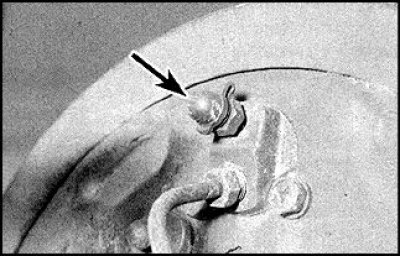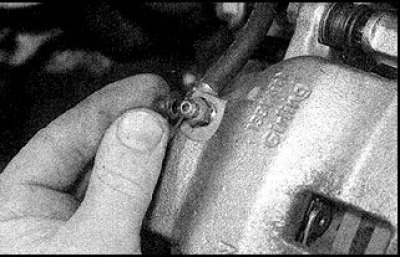When removing air, it is forbidden to add the used liquid.
1. In case of ingress of liquids other than the recommended one, the system should be flushed and all seals should be replaced.
2. Before removing the air, any violation of the tightness of the hydraulic drive must be eliminated.
3. Park the vehicle on a level surface, stop the engine and apply the handbrake.
4. Remove caps and wipe clean all fittings.
5. Remove the reservoir cap, add fluid to the MAX mark.
6. Loosely tighten the cap, keeping in mind that the liquid level must always be kept above the MIN·mark.
7. In the absence of a special set, work on removing air should be done by two people.
8. When using a special kit, follow the instructions that come with the kit.
9. Regardless of the method, the pumping sequence must be followed.
10. If the hydraulic drive is partially depressurized, then you can limit yourself to removing air only from the depressurized circuit.
11. Brake bleeding sequence: rear left, front right, rear right, front left.
12. Prepare a transparent vessel and hose.
 |  |
13. Put the hose on the fitting (on the left, the arrow indicates the fitting cap).
14. Place the other end of the hose into the vessel, pouring some liquid.
15. Check the fluid level in the reservoir.
16. Have an assistant depress and hold the brake pedal several times.
17. Loosen the screw 1 turn. When the liquid stops flowing out, wrap the fitting and ask the assistant to release the pedal.
18. Check the fluid level in the reservoir.
19. Repeat this cycle until air is removed from the system, as evidenced by the absence of bubbles in the fluid flowing through the hose. Between individual cycles, wait about 5 seconds.
20. Install the dust cap, tighten the fitting, remove the hose and put on the cap.
21. Repeat the procedure on the remaining wheels.
22. Check the fluid level in the reservoir.
23. At the end of bleeding, the brake pedal should be "tough".
24. Otherwise, repeat the procedure.
25. If, after repeated pumping, the pedal remains "soft", then the cause is the wear of the cuffs of the cylinders.